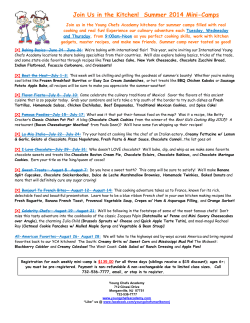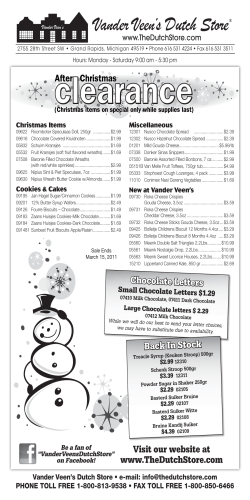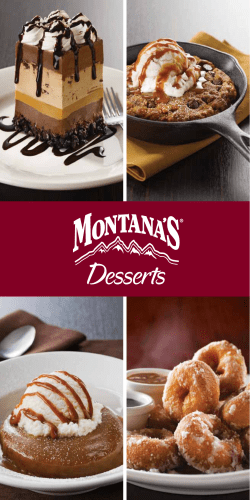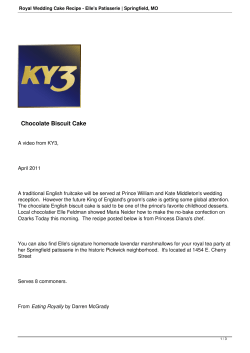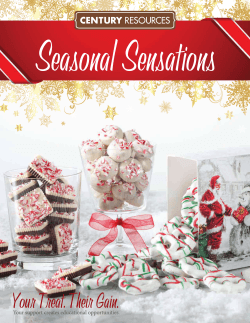
Tempering Chocolate
Tempering Chocolate What is Tempering? In order for chocolate to have its maximum aesthetic and utilitarian qualities, the chocolate needs to be prepared through a process called Tempering. To understand tempering, one needs to learn a bit about the chemistry of chocolate. Tempering is the act of pre-crystallizing the cocoa butter in chocolate. The ingredients of dark chocolate are cocoa liquor, cocoa butter, sugar and vanilla. Milk chocolate has the same ingredients, but with the addition of milk powder. White chocolate is only cocoa butter, sugar and milk powder; no cocoa liquor is used. Whether dark, milk or white chocolate, cocoa butter is the essential ingredient. When chocolate is heated, the crystals in cocoa butter break apart. There are 6 different forms of crystals in chocolate, but it is the beta crystals that produce the desired aesthetic qualities in chocolate. The beta crystal is also referred to as the stable crystal because its formation results in chocolate being hard, shiny, and with an even coloring. To pre-crystallize chocolate, you melt the chocolate to break apart the cocoa butter crystals. Then you stir and cool the chocolate so that the stable beta crystals are formed. It is at this point that the chocolate is ready for use. Chocolate does not stay tempered. As the chocolate cools, the chocolate begins to harden. This means that too many crystals have formed and the chocolate is now over-crystallized. This harden chocolate can be reused by re-tempering it. Tempering doesn’t impact taste. Chocolate that is not tempered or overcrystallized will taste the same as properly tempered chocolate. You temper chocolate to maximize the look and feel of the chocolate. Characteristics of Properly Tempered Chocolate When chocolate is properly tempered it will have the following characteristics: • Shine - Shiny and glossy when hard • Even coloring – The color and shine will be evenly distributed throughout the chocolate • Hardness - A crisp hardness that snaps when broken • Shrinkage - Clean and consistent shrinkage in molds If the chocolate is not properly tempered, it will 1) take a long time to harden, 2) have a grayish color, and 3) stick to moulds. Ways to Temper Writing with Chocolate April 2012 – Version 4 Page 2 of 8 There are different methods for tempering chocolate. These methods are defined by their means for heating or cooling the chocolate. Probably the oldest and most well known method involves heating the chocolate in a bainmarie (double-boiler). A more modern heating method is with a microwave. In terms of cooling, you can pour the chocolate on a cool surface, such as a granite or marble table and mix it on the table until it is cooled. Or you can cool the chocolate by adding un-melted chocolate to the warm chocolate to bring up the temperature, called seeding. Tools and Utensils for Tempering Chocolate You probably have all the tools and utensils you need for making chocolate already in your kitchen. • Microwave oven or double boiler • Plastic mixing bowls (microwave safe) • Plastic spatula • Big spoon for stirring (preferably plastic). • Cooking thermometer (You can use a regular or digital meat thermometer) STEP-BY-STEP INSTRUCTIONS These instructions offer a variety of methods for heating and cooling the chocolate. STEP 1 – Melting the Chocolate The first step in tempering chocolate is to melt it. Chocolate melts at 45 degrees Celsius. There are two simple and safe ways you can melt chocolate in your kitchen. The first is with a bain marie (double-boiler) and the second is with a microwave. Bain Marie (double-boiler): Because chocolate burns easily, one needs to keep the chocolate away from direct heat. This is accomplished using a double-boiler rather than a saucepan. Put the chocolate in a double boiler until it starts to melt. Once some of the chocolate is melted, stir regularly. As soon as most of the chocolate is melted, turn the heat off and stir. When the chocolate is completely melted, pour the chocolate into a plastic bowl. Chocolate heated in a microwave begins to melt from the inside. Be sure to stir after each 30 seconds to distribute the melted chocolate. Microwave: If you are going to use a microwave, put the chocolate in a plastic bowl that is no more than 2/3 full. Heat the chocolate in short intervals until it starts to melt. The amount of time will vary depending on how much chocolate you are using. If you have a large bowl, start with 2 -3 minutes. If you are using a tiny bowl, start with 1 minute. Stir regularly from the center outwards until the chocolate is melted. writingwithchocolate.com Writing with Chocolate April 2012 – Version 4 Page 3 of 8 How full: Do not fill the bowl more than 2/3 full. You will need room to mix the chocolate. If you fill the bowl to the top, it will be hard to stir without chocolate spilling out. Type of Bowl: You want to use plastic and not glass because you don’t want the bowl to retain heat. Temperature: Because the intensity of the heat can vary from microwave to microwave, use med-high instead of high to avoid burning the chocolate. If you melt the chocolate slowly in a microwave, you Once the chocolate starts to can melt it at precisely the temperature that chocolate melts without getting the chocolate hotter than it needs melt, stir it. The melted chocolate will help melt the unto be. The ability to have complete control of the melted chocolate. temperature of the chocolate is one of the advantages of using a microwave instead of a Bain Marie (double boiler). Step 2 – Cooling & Stirring the Chocolate Once the chocolate is melted you begin the cooling process. For properly tempered chocolate you need the temperature of the chocolate to be within a specific temperature range. Dark, milk and Temperatures for Tempering Chocolate white chocolate are tempered at Celsius Fahrenheit Type different temperatures. The 31° - 32° c 88° - 89° f Dark - Callebaut differences in cooling temperature 30° - 31° c 86° - 87° f Milk - Callebaut have to do with the amount of 82° - 84° f White - Callebaut 28° - 29° c protein in the chocolate. The more milk protein, the lower the temperature to melt and to cool. There are three popular ways to cool chocolate: Seeding, using a marble table, and letting the chocolate cool on its own. Seeding: With this method you slowly add un-melted chocolate (the same kind of chocolate that you melted) to the already melted chocolate. You do this until the desired temperature is reached. You start off adding handfuls of chocolate. At first the added chocolate will melt very rapidly. As the chocolate begins to cool, the added chocolate will take longer to melt and require more stirring. Stirring is very important in the tempering process. When the added chocolate no longer melts, then you are close to the desired temperature. This un-melted chocolate you are adding is already tempered. By adding tempered chocolate (un-melted chocolate) to melted chocolate you accomplish two essential steps in tempering: 1) the chocolate is cooled writingwithchocolate.com Writing with Chocolate April 2012 – Version 4 Page 4 of 8 down because the un-melted chocolate is at room temperature and 2) the tempered chocolate begins the chain reaction necessary to form the proper beta crystals. Marble Table: Another way to cool the chocolate is to pour 2/3 of the chocolate on a cool table, such as granite or marble, and mix the chocolate on the table until it is at the desired temperature. This mixing is important in forming the beta crystals. Once the chocolate is cool, you put the chocolate back in the bowl with the remaining chocolate and mix the chocolates together. This results in all the chocolate being properly tempered. Cooling Naturally: You can also just let the bowl of chocolate cool on its own. This can take up to 30 minutes or longer. You need to stir the chocolate throughout the cooling process. Measuring the Temperature To measure the temperature, you use a meat thermometer rather than a candy thermometer because a candy thermometer is for very high temperatures and a meat thermometer is for lower temperatures. With chocolate you try not to get it hotter than 45 degrees. The Effect of Ambient Room Temperature on Tempering Process Chocolate is highly sensitive to ambient room temperature. If you are working in a cool room the chocolate will cool more quickly than in a warm room. When working with chocolate, you always have to factor in the ambient room temperature and humidity. Checking the temperature of the chocolate. Importance of Stirring The right temperature on a thermometer does not insure that the chocolate is properly tempered. The chocolate also needs to be stirred. In fact, chocolate masters do not rely on a thermometer. They know when it is properly tempered by the look and feel of the chocolate when they are stirring it. One technique used by chocolate masters to test the temperature of chocolate is to put a dab under their bottom lip. Since chocolate melts at body temperature, if it feels hot, the chocolate is too hot. If it feels just right, then the chocolate is at the right temperature. The difference between chocolate chips and the chocolate used for making chocolates: There is a difference between the chocolate you use to make chocolate chip cookies and the chocolate used to make chocolate candy (or bon bons, as they are called in Belgium). Chocolate chips are heat stable chocolate so that they will not lose their shape and melt while baking. To make chocolate heat stable, less cocoa butter is added. The chocolate used to make candy (bon bons), writingwithchocolate.com Writing with Chocolate April 2012 – Version 4 Page 5 of 8 on the other hand, has more cocoa butter so that it will melt into a liquid form at 45° celcius. Step 3 – Testing if Properly Tempered You can test to make sure your chocolate is properly tempered and ready to use by dipping a spoon into the chocolate and then letting the spoon sit for 3-5 minutes. If the chocolate is properly tempered, the chocolate on the spoon will turn hard and glossy. If the chocolate is not tempered, the chocolate will still be liquid and/or will have a marble-like color indicating the fat and cocoa are still separated. When the chocolate starts to get Thick (Overcrystallization) When the chocolate cools too much, it will become thick. This means that the chocolate has started to overcrystallize. To get it back to a nice liquid form, you just need to re-temper. writingwithchocolate.com To check if the chocolate is properly tempered, put a little chocolate on a spoon. If it hardens within 3-4 minutes, the chocolate is ready. Writing with Chocolate April 2012 – Version 4 Page 6 of 8 Resources General Information on Working with Belgian Chocolate Writing with Chocolate URL: http://www.writingwithchocolate.com Reviews of Belgian chocolate shops and more. Supplies and Ingredients in Belgium Chocolate Colruyt and Makro regularly carry 2.5 kilo bags of Callebaut chocolate • Colruyt (for a listing of all locations go to www.colruty.be) • The bags of chocolate are on the bottom shelf in the chocolate candy aisle. When you get to the cash register, the person will ask you if you have a Facture card. Say no, and when you go to pay you will have to put your name and address on the receipt. I don’t know why this is required, but I’ve bought 2.5 k bags of Callebaut at several Colruyts and I always have to go through this procedure. • Makro (for a listing of all locations go to www.makro.be) Chocolate Making Supplies Chocolate World A cash and carry warehouse of chocolate making supplies and chocolate molds Location: Lange Elzenstraat 18, 2018, Antwerpen, Belgium URL: http://www.chocolateworld.be Packaging, Decorations and Paper Supplies Ava A party and paper supply store that also sells chocolate ballotin boxes. Locations: 1) Brusselsesteenweg 490 - 3090 Overijse and 2) SintJans-Molenbeek , Koolmijnenkaai 80-82 - 1080 Brussel URL: http://www.ava.be Belgian Sweets Design Cash and carry warehouse of chocolate packaging and decoration supplies. This is where the chocolatiers go for their boxes, bags, and bows. Location: Av. Z. Grammelaan, 16, Saintes 1480 Sint-Renelde Belgium URL: http://www.bsd.be writingwithchocolate.com Writing with Chocolate April 2012 – Version 4 Page 7 of 8 Online Instructions How to Temper Chocolate Tempering Chocolate By: Callebaut URL: http://www.callebaut.com/usen/333 Step by step written instructions on different methods of tempering chocolate. • Tempering on a cold (marble) work surface http://www.callebaut.com/usen/2054 • Tempering with callets (also called seeding) http://www.callebaut.com/usen/2055 • Tempering with a microwave. http://www.callebaut.com/usen/2053 • Video dubbed in English on how to temper (precrystallization) in a microwave http://www.callebaut.com/usen/4846 Chocolate Tempering: How To Temper Chocolate By: David Lebovitz’s blog “Living the Sweet Life in Paris.” URL: http://www.davidlebovitz.com/2005/08/temperingchoco/ One of the best write-ups on why tempering chocolate is necessary and what happens when chocolate is improperly tempered. You will also find instructions for tempering using a double boiler. How to Use Molds By: Callebaut URL: http://www.callebaut.com/usen/604 Video on how to work with hollow figure and praline molds • Pouring into molds http://www.callebaut.com/usen/2058 • Pouring hollow figures with single molds http://www.callebaut.com/usen/2079 • Pouring hollow figures with double molds http://www.callebaut.com/usen/2078 • Chocolate (pralines) http://www.callebaut.com/usen/2080 Dipping/Enrobing Chocolates By: Callebaut URL: http://www.callebaut.com/usen/605 Video on how to enrobe chocolate • Dipping chocolates/petits fours/biscuits http://www.callebaut.com/usen/2526 writingwithchocolate.com Writing with Chocolate April 2012 – Version 4 Page 8 of 8 Chocolate Library Making Chocolate David Lebovitz. The Great Book of Chocolate: The Chocolate Lover’s Guide with Recipes. (Berkeley: Ten Speed Press, 2004). ABOUT: A personal and entertaining look at chocolate covering its history, how it’s made, as well as recipes and resources. Ewald Notter, et at. The Art of the Chocolatier: From Classic Confections to Sensational Showpieces. (New York: John Wiley & Sons, 2011). ABOUT: This is an almost encyclopedic coverage of chocolate making. If you want to understand the tools, techniques, and tastes of chocolate making in detail, then this is the book for you. Andrew Garrison Shotts. Making Artisan Chocolates (Providence, RI: Quarry Books, 2007) ABOUT: This is my go-to book for great recipes. The instructions are clear and everything tastes as good as it sounds. History Sophie D. Coe and Michael D. Coe. The True History of Chocolate, 2nd edition (New York: Thames & Hudson, 2007). ABOUT: Considered one of the best books on the history of chocolate. This book was written by an anthropologist (published posthumously by her husband) and combines the best of historical analysis with the sensitivity of ethnographic research to bring the complex history of chocolate in the old world and new world to life. Health Benefits Rowan Jacobsen. Chocolate Unwrapped: The Surprising Health benefits of America’s Favorite Passion (Montpelier, Vermont: Invisible Cities Press, 2003). ABOUT: A little book of general information on the health benefits of chocolate. This is not a technical or medical reference; rather it is merely a good place to start. Chocolate Trivia Linda K. Fuller. Chocolate Fads , Folkore, & Fantasies: 1,000+ Chucks of Chocolate Information. (New York: Harrington Park Press, 1994). ABOUT: The publication date may be almost 20 years ago, but the fun facts and bits of useless information will satisfy a chocolate trivia sweet tooth. writingwithchocolate.com
© Copyright 2025
